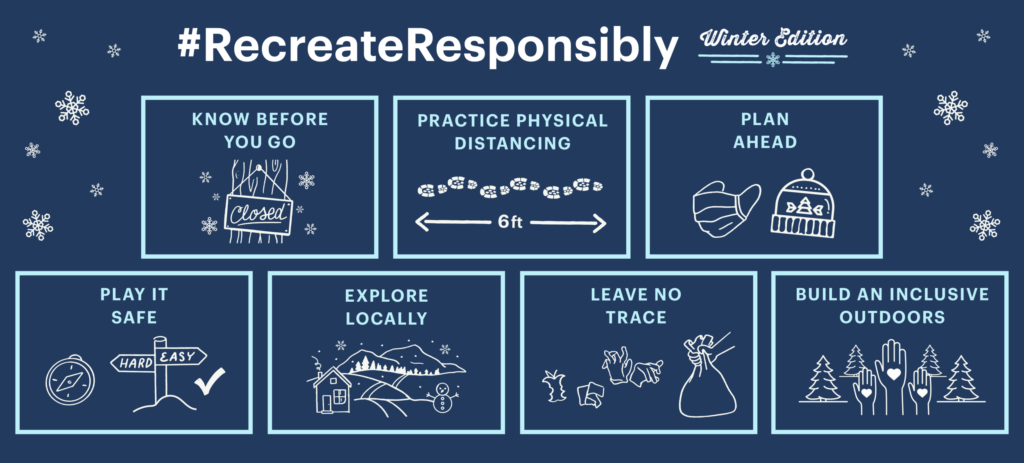With the onset of winter weather, and the uptick in COVID cases, we recognize that the outdoors will attract even more winter recreators than usual. Many of those visitors will be first-time users, unprepared for the differences between winter and summer safety precautions! Already, Search and Rescue units in King and Kittitas County have received record numbers of calls for lost, stranded, and hypothermic people. SAR volunteers are already worn thin after a long and frenetic summer season, so let’s give them a break by being smart about how we play in the snow.
The elite team over at www.recreateresponsibly.org has updated their COVID-safe recreation guidelines for the winter season:


Other things to consider:
- Let someone know where you are going, when you will be back, and then STICK TO THE PLAN. This should include exact directions and a hard timeline with guidance of what to do when you miss a deadline. Agency staff often get calls from concerned family members that don’t know where someone is, or even if they are ok – please help reduce unnecessary calls by briefing your loved ones beforehand!
- ‘Know Before You Go’ is both a good maxim, and the longtime slogan of Avalanche Awareness programs. While we use it here in a general sense, please visit KBYG.org for free avalanche trainings geared towards all winter users, including skiers, snowboarders, sledders, snowshoers, alpinists, etc.
- Invest in a locator device, or put one on your Christmas List! Many commercially available locators are capable of communicating even where there is no cell service.
- Most phones have apps that can track your location, but that’s only helpful if they have battery. When out and about, manage your battery power – put it in airplane mode, take photos sparingly, and share them to social media when you’re safely back at home. Keep in mind that many batteries drain more quickly in the cold, and store your phone in an inside pocket!
- Recreate within the limits of your vehicle! Your mini van, sedan, trusty VW Bug, Grandpa’s old Buick 225 etc, might be a great daily driver, but not for winter forest road travel. If you are going to the mountains, please drive a well prepared rig, understand its controls and know its limitations.
- Don’t go alone, don’t exceed your vehicles capabilities.
- If you are new to winter/forest road travel but have a vehicle with multiple wheel drive, travel while it’s doing well, when you start to struggle, TURN AROUND.
- Nicely groomed snowmobile trails are for snowmobiles, not your wheeled vehicle.
- Be extra cautious on winter roads, slow down in corners, if you have to park, do your best to be out of the way of others that might have to squeeze by you.
- Always expect the road to be slick, or a vehicle to be coming around a corner in your lane or a tree down across the road.
- Add extra gear to your winter kit, so that you can assist others who are less prepared. Many household or inexpensive items can really make a difference when you’re in a jam:
- Shovel
- Extra blankets
- Plenty of water
- Backup communication gear
- Hand warmers (available at any gas station checkout!)
- Dry extra socks
- Extra gloves
- Extra clothing layers (sweaters, flannels, etc)
- A spare jacket
- Flashlight or other lantern options
- A whistle
- Trailmix or other snack packs
- Shingles, cat litter, or other materials that can be wedged under tires to create traction
Remember there is no such thing as ‘just a quick trip’ in winter. Any outing (especially one on remote Forest Service roads) can lead to a long night, or over night. Be prepared for the worst, and worry about the clutter in your vehicle when spring arrives!